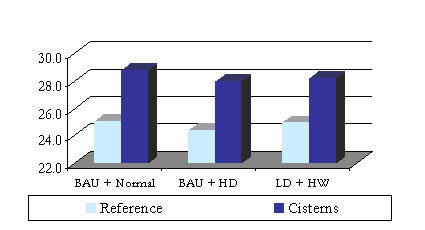
ISSUE 6 |
||||||||||||||||||||||||||||||||||||||||||||||||||||
|
|
|||||||||||||||||||||||||||||||||||||||||||||||||||
|
Table 1. Estimated capacity and cost for cisterns (Assuming an average cost of approximately 2,200 €/cistern)
|
||||||||||||||||||||||||||||||||||||||||||||||||||||
Option results |
||||||||||||||||||||||||||||||||||||||||||||||||||||
|
Figure 1 presents the total volume of water stored and used during the summer.This abstraction may vary according to the water availability for each year. Figure 2 presents abstractions from the cisterns in the Paroikia municipal department for the three scenarios in year 2009. Figure 1. Cistern Abstractions under the BAU + Normal scenario For an average year, cisterns are used during September and October, since available supply is adequate to meet the August peak. In cases of drought and limited available resources, abstraction takes place in August, while for wet years cisterns are not needed at all. Figure 2. Abstractions from Paroikia cisterns under the three scenarios (2009) |
||||||||||||||||||||||||||||||||||||||||||||||||||||
|
|
||||||||||||||||||||||||||||||||||||||||||||||||||||
Effectiveness |
||||||||||||||||||||||||||||||||||||||||||||||||||||
|
Domestic deficit does not present any significant improvement; as demand escalates, the initial improvement of 10% falls to approximately 3% in 2030 (Figure 3 and Figure 4). The small increase in groundwater abstractions, used to fill up the cisterns, results in a similar deterioration of irrigation deficit and decreases in effectiveness (Figure 5 and Figure 6).
Figure 3. Percent demand coverage effectiveness of Cisterns to Domestic use Figure 4. Percent Improvement of deficit in Domestic use with respect to the reference scenarios Overall, the option can help to alleviate some pressure on available resources during the high demanding summer months while improving the reliability of domestic supply. Of course the small capacity cannot adequately meet the structural deficit appearing in some municipal departments, and an expansion of the application of the option in the hotel sector is considered unrealistic. Additionally, the measure is not effective in cases of drought and escalating demand. Figure 5. Percent demand coverage effectiveness of Cisterns to Irrigation use
Figure 6. Percent Improvement of deficit in Irrigation use |
||||||||||||||||||||||||||||||||||||||||||||||||||||
Direct and Environmental Costs |
||||||||||||||||||||||||||||||||||||||||||||||||||||
|
Figure 7 presents the direct cost (expressed as the present value over the period 2004-2030) between the three scenarios after cistern construction. In all three cases, direct costs increase about 15-16% due to the high subsidies for allowing the penetration of cisterns into the supply system.
Figure 7. Total direct cost difference of the Cisterns option Environmental costs present a marginal increase, due to the augmentation of groundwater abstractions, that are used for filling up the cisterns during the low peak months (Figure 8).
Figure 8. Total environmental cost difference of the Cisterns option |
||||||||||||||||||||||||||||||||||||||||||||||||||||







